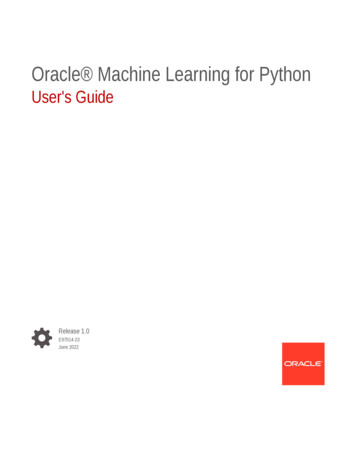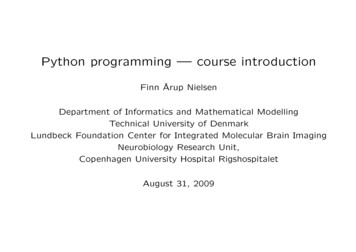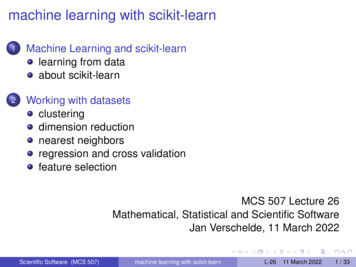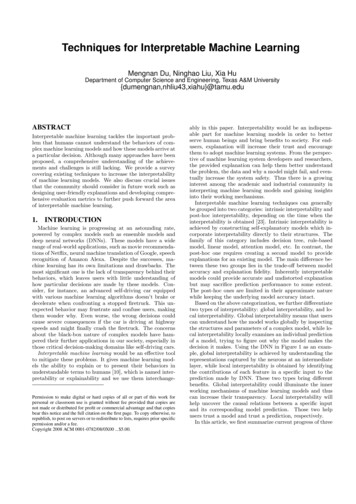
Transcription
InterpretableMachine Learningwith PythonLearn to build interpretable high-performancemodels with hands-on real-world examplesSerg MasísBIRMINGHAM—MUMBAI
Interpretable Machine Learning with PythonCopyright 2021 Packt PublishingAll rights reserved. No part of this book may be reproduced, stored in a retrieval system, ortransmitted in any form or by any means, without the prior written permission of the publisher,except in the case of brief quotations embedded in critical articles or reviews.Every effort has been made in the preparation of this book to ensure the accuracy of theinformation presented. However, the information contained in this book is sold without warranty,either express or implied. Neither the author, nor Packt Publishing or its dealers and distributors,will be held liable for any damages caused or alleged to have been caused directly or indirectly bythis book.Packt Publishing has endeavored to provide trademark information about all of the companiesand products mentioned in this book by the appropriate use of capitals. However, Packt Publishingcannot guarantee the accuracy of this information.Group Product Manager: Kunal ParikhPublishing Product Manager: Sunith ShettyAcquisition Editor: Reshma RamanSenior Editor: Roshan KumarContent Development Editors: Sean Lobo and Joseph SunilTechnical Editor: Sonam PandeyCopy Editor: Safis EditingProject Coordinator: Aishwarya MohanProofreader: Safis EditingIndexer: Priyanka DhadkeProduction Designer: Roshan KawaleFirst published: March 2021Production reference: 1250321Published by Packt Publishing Ltd.Livery Place35 Livery StreetBirminghamB3 2PB, UK.ISBN 978-1-80020-390-7www.packt.com
1Interpretation,Interpretability,and Explainability;and Why Does ItAll Matter?We live in a world whose rules and procedures are governed by data and algorithms.For instance, there are rules as to who gets approved for credit or released on bail, andwhich social media posts might get censored. There are also procedures to determinewhich marketing tactics are most effective and which chest x-ray features might diagnosea positive case of pneumonia.You expect this because it is nothing new!
4Interpretation, Interpretability, and Explainability; and Why Does It All Matter?But not so long ago, rules and procedures such as these used to be hardcoded intosoftware, textbooks, and paper forms, and humans were the ultimate decision-makers.Often, it was entirely up to human discretion. Decisions depended on human discretionbecause rules and procedures were rigid and, therefore, not always applicable. There werealways exceptions, so a human was needed to make them.For example, if you would ask for a mortgage, your approval depended on an acceptableand reasonably lengthy credit history. This data, in turn, would produce a credit scoreusing a scoring algorithm. Then, the bank had rules that determined what score was goodenough for the mortgage you wanted. Your loan officer could follow it or override it.These days, financial institutions train models on thousands of mortgage outcomes, withdozens of variables. These models can be used to determine the likelihood that you woulddefault on a mortgage with a presumed high accuracy. If there is a loan officer to stampthe approval or denial, it's no longer merely a guideline but an algorithmic decision. Howcould it be wrong? How could it be right?Hold on to that thought because, throughout this book, we will be learning the answers tothese questions and many more!To interpret decisions made by a machine learning model is to find meaning in it, butfurthermore, you can trace it back to its source and the process that transformed it.This chapter introduces machine learning interpretation and related concepts such asinterpretability, explainability, black-box models, and transparency. This chapter providesdefinitions for these terms to avoid ambiguity and underpins the value of machinelearning interpretability. These are the main topics we are going to cover: What is machine learning interpretation? Understanding the difference between interpretation and explainability A business case for interpretabilityLet's get started!Technical requirementsTo follow the example in this chapter, you will need Python 3, either running in a Jupyterenvironment or in your favorite integrated development environment (IDE) such asPyCharm, Atom, VSCode, PyDev, or Idle. The example also requires the requests,bs4, pandas, sklearn , matplotlib, and scipy Python libraries. The codefor this chapter is located here: achine-Learning-with-Python/tree/master/Chapter01.
What is machine learning interpretation?5What is machine learning interpretation?To interpret something is to explain the meaning of it. In the context of machine learning,that something is an algorithm. More specifically, that algorithm is a mathematical onethat takes input data and produces an output, much like with any formula.Let's examine the most basic of models, simple linear regression, illustrated in thefollowing formula:̂𝑦𝑦 𝛽𝛽0 𝛽𝛽1 𝑥𝑥1Once fitted to the data, the meaning of this model is that 𝑦𝑦̂ predictions are a weightedsum of the 𝑥𝑥 features with the 𝛽𝛽 coefficients. In this case, there's only one 𝑥𝑥 feature orpredictor variable, and the 𝑦𝑦 variable is typically called the response or target variable.A simple linear regression formula single-handedly explains the transformation, whichis performed on the input data 𝑥𝑥1 to produce the output 𝑦𝑦̂. The following example canillustrate this concept in further detail.Understanding a simple weight prediction modelIf you go to this web page maintained by the University of California, http://wiki.stat.ucla.edu/socr/index.php/SOCR Data Dinov 020108HeightsWeights, you can find a link to download a dataset of 25,000 synthetic recordsof weights and heights of 18-year-olds. We won't use the entire dataset but only the sampletable on the web page itself with 200 records. We scrape the table from the web page andfit a linear regression model to the data. The model uses the height to predict the weight.In other words, 𝑥𝑥1 height and 𝑦𝑦 weight , so the formula for the linear regression modelwould be as follows:weight 𝛽𝛽0 𝛽𝛽1 heightYou can find the code for this example here: WeightPrediction.ipynb.To run this example, you need to install the following libraries: requests to fetch the web page bs4 (Beautiful Soup) to scrape the table from the web page pandas to load the table in to a dataframe sklearn (scikit-learn) to fit the linear regression model and calculate its error
6Interpretation, Interpretability, and Explainability; and Why Does It All Matter? matplotlib to visualize the model scipy to test the correlationYou should load all of them first, as follows:Import mathimport requestsfrom bs4 import BeautifulSoupimport pandas as pdfrom sklearn import linear modelfrom sklearn.metrics import mean absolute errorimport matplotlib.pyplot as pltfrom scipy.stats import pearsonrOnce the libraries are all loaded, you use requests to fetch the contents of the web page,like this:url \'http://wiki.stat.ucla.edu/socr/index.php/SOCR DataDinov 020108 HeightsWeights'page requests.get(url)Then, take these contents and scrape out just the contents of the table withBeautifulSoup, as follows:soup BeautifulSoup(page.content, 'html.parser')tbl soup.find("table",{"class":"wikitable"})pandas can turn the raw HyperText Markup Language (HTML) contents of the tableinto a dataframe, as illustrated here:height weight df pd.read s)']]And voilà! We now have a dataframe with Heights(Inches) in one column andWeights(Pounds) in another. As a sanity check, we can then count the number ofrecords. This should be 200. The code is shown here:num records height weight df.shape[0]print(num records)
What is machine learning interpretation?7Now that we have confirmed that we have the data, we must transform it so that itconforms to the model's specifications. sklearn needs it as NumPy arrays with (200,1)dimensions, so we must first extract the Height(Inches) and Weight(Pounds)pandas Series. Then, we turn them into (200, ) NumPy arrays, and, finally, reshapethem into (200,1) dimensions. The following commands perform all the necessarytransformation operations:x height weight df['Height(Inches)'].values.\reshape(num records, 1)y height weight df['Weight(Pounds)'].values.\reshape(num records, 1)Then, you initialize the scikit-learn LinearRegression model and fit it with thetraining data, as follows:model linear model.LinearRegression() model.fit(x,y)To output the fitted linear regression model formula in scikit-learn, you must extract theintercept and coefficients. This is the formula that explains how it makes predictions:print("ŷ " str(model.intercept [0]) " " \str(model.coef .T[0][0]) " x₁")The following is the output:ŷ -106.02770644878132 3.432676129271629 x1This tells us that, on average, for every additional pound, there are 3.4 inches of height.However, explaining how the model works is only one way to explain this linear regressionmodel, and this is only one side of the story. The model isn't perfect because the actualoutcomes and the predicted outcomes are not the same for the training data. Thedifference between both is the error or residuals.There are many ways of understanding an error in a model. You can use an error functionsuch as mean absolute error to measure the deviation between the predicted valuesand the actual values, as illustrated in the following code snippet:y pred model.predict(x)mae mean absolute error(y, y pred)print(mae)
8Interpretation, Interpretability, and Explainability; and Why Does It All Matter?The following is the output:7.7587373803882205A 7.8 mean absolute error means that, on average, the prediction is 7.8 pounds fromthe actual amount, but this might not be intuitive or informative. Visualizing the linearregression model can shed some light on how accurate these predictions truly are.This can be done by using a matplotlib scatterplot and overlaying the linear model(in blue) and the mean absolute error (as two parallel bands in gray), as shown in thefollowing code snippet:plt.scatter(x, y, color 'black')plt.plot(x, y pred, color 'blue', linewidth 3)plt.plot(x, y pred mae, color 'lightgray')plt.plot(x, y pred - mae, color ('Weight(Pounds)')If you run the preceding snippet, the plot shown here in Figure 1.1 is what you get asthe output:Figure 1.1 – Linear regression model to predict weight based on height
What is machine learning interpretation?As you can appreciate from the plot in Figure 1.1, there are many times in which theactuals are 20 25 pounds away from the prediction. Yet the mean absolute error canfool you into thinking that the error is always closer to 8. This is why it is essential tovisualize the error of the model to understand its distribution. Judging from this graph,we can tell that there are no red flags that stand out about this distribution, such asresiduals being more spread out for one range of heights than for others. Since it is moreor less equally spread out, we say it's homoscedastic. In the case of linear regression, thisis one of many model assumptions you should test for, along with linearity, normality,independence, and lack of multicollinearity (if there's more than one feature). Theseassumptions ensure that you are using the right model for the job. In other words, theheight and weight can be explained with a linear relationship, and it is a good idea to doso, statistically speaking.With this model, we are trying to establish a linear relationship between 𝑥𝑥 height and𝑦𝑦 weight. This association is called a linear correlation. One way to measure thisrelationship's strength is with Pearson's correlation coefficient. This statistical methodmeasures the association between two variables using their covariance divided by theirstandard deviations. It is a number between 1 and 1 whereby the closer the numberit is to zero, the weaker the association is. If the number is positive, there is a positiveassociation, and if it's negative, there is a negative one. In Python, you can computePearson's correlation coefficient with the pearsonr function from scipy, asillustrated here:corr, pval pearsonr(x[:,0], y[:,0])print(corr)The following is the output:0.5568647346122992The number is positive, which is no surprise because as height increases, weight alsotends to increase, but it is also closer to 1 than to 0, denoting that it is strongly correlated.The second number produced by the pearsonr function is the 𝑝𝑝-value for testingnon-correlation. If we test that it's less than an error level of 5%, we can say there'ssufficient evidence of this correlation, as illustrated here:print(pval 0.05)The following is the output:True9
10Interpretation, Interpretability, and Explainability; and Why Does It All Matter?Understanding how a model performs and in which circumstances can help us explainwhy it makes certain predictions, and when it cannot. Let's imagine we are asked toexplain why someone who is 71 inches tall was predicted to have a weight of 134 poundsbut instead weighed 18 pounds more. Judging from what we know about the model,this margin of error is not unusual even though it's not ideal. However, there are manycircumstances in which we cannot expect this model to be reliable. What if we were askedto predict the weight of a person who is 56 inches tall with the help of this model? Couldwe assure the same level of accuracy? Definitely not, because we fit the model on the dataof subjects no shorter than 63 inches. Ditto if we were asked to predict the weight of a9-year-old, because the training data was for 18-year-olds.Despite the acceptable results, this weight prediction model was not a realistic example.If you wanted to be more accurate but—more importantly—faithful to what can reallyimpact the weight of an individual, you would need to add more variables. You can add—say—gender, age, diet, and activity level. This is where it gets interesting because you haveto make sure it is fair to include them, or not to include them. For instance, if genderwere included yet most of our dataset was composed of males, how could you ensureaccuracy for females? This is what is called selection bias. And what if weight had more todo with lifestyle choices and circumstances such as poverty and pregnancy than gender?If these variables aren't included, this is called omitted variable bias. And then, does itmake sense to include the sensitive gender variable at the risk of adding bias to the model?Once you have multiple features that you have vetted for fairness, you can find out andexplain which features impact model performance. We call this feature importance.However, as we add more variables, we increase the complexity of the model.Paradoxically, this is a problem for interpretation, and we will explore this in further detailin the following chapters. For now, the key takeaway should be that model interpretationhas a lot to do with explaining the following:1. Can we explain that predictions were made fairly?2. Can we trace the predictions reliably back to something or someone?3. Can we explain how predictions were made? Can we explain how the model works?And ultimately, the question we are trying to answer is this:Can we trust the model?
What is machine learning interpretation?11The three main concepts of interpretable machine learning directly relate to thethree preceding questions and have the acronym of FAT, which stands for fairness,accountability, and transparency. If you can explain that predictions were made withoutdiscernible bias, then there is fairness. If you can explain why it makes certain predictions,then there's accountability. And if you can explain how predictions were made and howthe model works, then there's transparency. There are many ethical concerns associatedto these concepts, as shown here in Figure 1.2:Figure 1.2 – Three main concept of Interpretable Machine LearningSome researchers and companies have expanded FAT under a larger umbrella of ethicalartificial intelligence (AI), thus turning FAT into FATE. Ethical AI is part of an evenlarger discussion of algorithmic and data governance. However, both concepts very muchoverlap since interpretable machine learning is how FAT principles and ethical concernsget implemented in machine learning. In this book, we will discuss ethics in this context.For instance, Chapter 13, Adversarial Robustness relates to reliability, safety, and security.Chapter 11, Mitigating Bias and Causal Inference Methods relates to fairness. That beingsaid, interpretable machine learning can be leveraged with no ethical aim in mind, andalso for unethical reasons.
12Interpretation, Interpretability, and Explainability; and Why Does It All Matter?Understanding the difference betweeninterpretability and explainabilitySomething you've probably noticed when reading the first few pages of this book isthat the verbs interpret and explain, as well as the nouns interpretation and explanation,have been used interchangeably. This is not surprising, considering that to interpret isto explain the meaning of something. Despite that, the related terms interpretability andexplainability should not be used interchangeably, even though they are often mistakenfor synonyms.What is interpretability?Interpretability is the extent to which humans, including non-subject-matter experts,can understand the cause and effect, and input and output, of a machine learning model.To say a model has a high level of interpretability means you can describe in a humaninterpretable way its inference. In other words, why does an input to a model producea specific output? What are the requirements and constraints of the input data? Whatare the confidence bounds of the predictions? Or, why does one variable have a moresubstantial effect than another? For interpretability, detailing how a model works is onlyrelevant to the extent that it can explain its predictions and justify that it's the right modelfor the use case.In this chapter's example, you could explain that there's a linear relationship betweenhuman height and weight, so using linear regression rather than a non-linear modelmakes sense. You can prove this statistically because the variables involved don't violatethe assumptions of linear regression. Even when statistics are on our side, you still oughtto consult with the domain knowledge area involved in the use case. In this one, we restassured, biologically speaking, because our knowledge of human physiology doesn'tcontradict the connection between height and weight.
Understanding the difference between interpretability and explainability13Beware of complexityMany machine learning models are inherently harder to understand simply because ofthe math involved in the inner workings of the model or the specific model architecture.In addition to this, many choices are made that can increase complexity and make themodels less interpretable, from dataset selection to feature selection and engineering,to model training and tuning choices. This complexity makes explaining how it works achallenge. Machine learning interpretability is a very active area of research, so there's stillmuch debate on its precise definition. The debate includes whether total transparency isneeded to qualify a machine learning model as sufficiently interpretable. This book favorsthe understanding that the definition of interpretability shouldn't necessarily excludeopaque models, which, for the most part, are complex, as long as the choices made don'tcompromise their trustworthiness. This compromise is what is generally called post-hocinterpretability. After all, much like a complex machine learning model, we can't explainexactly how a human brain makes a choice, yet we often trust its decision because we canask a human for their reasoning. Post-hoc machine learning interpretation is exactly thesame thing, except it's a human explaining the reasoning on behalf of the model. Usingthis particular concept of interpretability is advantageous because we can interpret opaquemodels and not sacrifice the accuracy of our predictions. We will discuss this in furtherdetail in Chapter 3, Interpretation Challenges.When does interpretability matter?Decision-making systems don't always require interpretability. There are two cases that areoffered as exceptions in research, outlined here: When incorrect results have no significant consequences. For instance, whatif a machine learning model is trained to find and read the postal code in apackage, occasionally misreads it, and sends it elsewhere? There's little chance ofdiscriminatory bias, and the cost of misclassification is relatively low. It doesn'toccur often enough to magnify the cost beyond acceptable thresholds. When there are consequences, but these have been studied sufficiently and validatedenough in the real world to make decisions without human involvement. This is thecase with a traffic-alert and collision-avoidance system (TCAS), which alerts thepilot of another aircraft that poses a threat of a mid-air collision.
14Interpretation, Interpretability, and Explainability; and Why Does It All Matter?On the other hand, interpretability is needed for these systems to have thefollowing attributes: Minable for scientific knowledge: Meteorologists have much to learn from aclimate model, but only if it's easy to interpret. Reliable and safe: The decisions made by a self-driving vehicle must be debuggableso that its developers can understand points of failure. Ethical: A translation model might use gender-biased word embeddings that resultin discriminatory translations, but you must be able to find these instances easily tocorrect them. However, the system must be designed in such a way that you can bemade aware of a problem before it is released to the public. Conclusive and consistent: Sometimes, machine learning models may haveincomplete and mutually exclusive objectives—for instance, a cholesterol-controlsystem may not consider how likely a patient is to adhere to the diet or drugregimen, or there might be a trade-off between one objective and another, such assafety and non-discrimination.By explaining the decisions of a model, we can cover gaps in our understanding of theproblem—its incompleteness. One of the most significant issues is that given the highaccuracy of our machine learning solutions, we tend to increase our confidence level to apoint where we think we fully understand the problem. Then, we are misled into thinkingour solution covers ALL OF IT!At the beginning of this book, we discussed how levering data to produce algorithmicrules is nothing new. However, we used to second-guess these rules, and now we don't.Therefore, a human used to be accountable, and now it's the algorithm. In this case,the algorithm is a machine learning model that is accountable for all of the ethicalramifications this entails. This switch has a lot to do with accuracy. The problem is thatalthough a model may surpass human accuracy in aggregate, machine learning modelshave yet to interpret its results like a human would. Therefore, it doesn't second-guessits decisions, so as a solution it lacks a desirable level of completeness. and that's why weneed to interpret models so that we can cover at least some of that gap. So, why is machinelearning interpretation not already a standard part of the pipeline? In addition to ourbias toward focusing on accuracy alone, one of the biggest impediments is the dauntingconcept of black-box models.
Understanding the difference between interpretability and explainability15What are black-box models?This is just another term for opaque models. A black box refers to a system in which onlythe input and outputs are observable, and you cannot see what is transforming the inputsinto the outputs. In the case of machine learning, a black-box model can be opened, butits mechanisms are not easily understood.What are white-box models?These are the opposite of black-box models (see Figure 1.3). They are also known astransparent because they achieve total or near-total interpretation transparency. Wecall them intrinsically interpretable in this book, and we cover them in more detail inChapter 3, Interpretation Challenges.Have a look at a comparison between the models here:Figure 1.3 – Visual comparison between white- and black-box models
16Interpretation, Interpretability, and Explainability; and Why Does It All Matter?What is explainability?Explainability encompasses everything interpretability is. The difference is that it goesdeeper on the transparency requirement than interpretability because it demands humanfriendly explanations for a model's inner workings and the model training process, andnot just model inference. Depending on the application, this requirement might extend tovarious degrees of model, design, and algorithmic transparency. There are three types oftransparency, outlined here: Model transparency: Being able to explain how a model is trained step by step.In the case of our simple weight prediction model, we can explain how theoptimization method called ordinary least squares finds the 𝛽𝛽 coefficient thatminimizes errors in the model. Design transparency: Being able to explain choices made, such as modelarchitecture and hyperparameters. For instance, we could justify these choices basedon the size or nature of the training data. If we were performing a sales forecastand we knew that our sales had a seasonality of 12 months, this could be a soundparameter choice. If we had doubts, we could always use some well-establishedstatistical method to find the right seasonality. Algorithmic transparency: Being able to explain automated optimizations suchas grid search for hyperparameters; but note that the ones that can't be reproducedbecause of their random nature—such as random search for hyperparameteroptimization, early stopping, and stochastic gradient descent—make the algorithmnon-transparent.Opaque models are called opaque simply because they lack model transparency, but formany models this is unavoidable, however justified the model choice might be. In manyscenarios, even if you outputted the math involved in—say—training a neural network ora random forest, it would raise more doubts than generate trust. There are at least a fewreasons for this, outlined here: Not "statistically grounded": An opaque model training process maps an inputto an optimal output, leaving behind what appears to be an arbitrary trail ofparameters. These parameters are optimized to a cost function but are not groundedin statistical theory. Uncertainty and non-reproducibility: When you fit a transparent model withthe same data, you always get the same results. On the other hand, opaque modelsare not equally reproducible because they use random numbers to initializetheir weights or to regularize or optimize their hyperparameters, or make use ofstochastic discrimination (such is the case for Random Forest).
Understanding the difference between interpretability and explainability17 Overfitting and the curse of dimensionality: Many of these models operate in ahigh-dimensional space. This doesn't elicit trust because it's harder to generalizeon a larger number of dimensions. After all, there's more opportunity to overfit amodel, the more dimensions you add. Human cognition and the curse of dimensionality: Transparent models areoften used for smaller datasets with fewer dimensions, and even if they aren't atransparent model, never use more dimensions than necessary. They also tend tonot complicate the interactions between these dimensions more than necessary. Thislack of unnecessary complexity makes it easier to visualize what the model is doingand its outcomes. Humans are not very good at understanding many dimensions, sousing transparent models tends to make this much easier to understand. Occam's razor: This is what is called the principle of simplicity or parsimony.It states that the simplest solution is usually the right one. Whether true or not,humans also have a bias for simplicity, and transparent models are known for— ifanything—their simplicity.Why and when does explainability matter?Trustworthy and ethical decision-making is the main motivation for interpretability.Explainability has additional motivations such as causality, transferability, andinformativeness. Therefore, there are many use cases in which total or nearly totaltransparency is valued, and rightly so. Some of these are outlined here: Scientific research: Reproducibility is essential to the scientific method. Also, usingstatistically grounded optimization methods is especially desirable when causalityneeds to be proven. Clinical trials: These must also produce reproducible findings and be statisticallygrounded. In addition to this, given the potential gravity of overfitting, they mustuse the fewest dimensions possible and models that don't complicate them. Consumer product safety testing: Much as with clinical trials, when life-and-deathsafety is a concern, simplicity is preferred whenever possible.
18Interpretation, Interpretability, and Explainability; and Why Does It All Matter? Public policy and law: This is a more nuanced discussion, as part of what is calledby law scholars algorithmic governance, and they have distinguished betweenfishbowl transparency and reasoned transparency. The former is closer to therigor required for consumer product safety testing, and the latter is one wherepost-hoc interpretability would suffice. One day, the government could be entirelyrun by alg
This chapter introduces machine learning interpretation and related concepts such as interpretability, explainability, black-box models, and transparency. This chapter provides definitions for these terms to avoid ambiguity and underpins the value of machine learning interpretability. These are the main topics we are going to cover:











